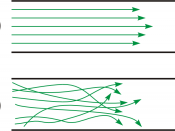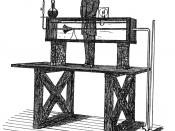It was in 1883 when Osborne Reynolds, a famous scientist and engineer tried to experiment on the relationship between the stability of fluid motion and the transition to turbulence. His final apparatus consisted of a glass-sided tank, 6 feet long, 18 inches deep and 18 inches wide. Inside it was a glass tube with `a trumpet mouth of varnished wood, great care being taken to make the surface of the wood continuous with that of the glass'. On the right-hand side, the tube was connected to an iron pipe equipped with a valve which could be controlled by means of a long lever. On the left-hand side is the device for introducing a streak of dye into the trumpet, while a float and dial indicated the water-level in the tank and hence the volume being discharged through the glass tube. The experiment, made in 1880, consisted of filling the tank with water, allowing several hours for conditions to become steady, then opening the valve, at first only slightly (http://www.eng.man.ac.uk).
Fig. 2.1. The Reynolds' ApparatusThe average flow velocity V could be defined if the volume flow rate Q was measured by capturing the flow in a bucket, and divided by the cross-sectional area of the pipe, A. In the first fluid flow rate in the downstream direction, the dye filament stayed straight and steady. This indicated that a smooth, well-behaved flow was maintained near the centerline and that Q was low enough. As the flow rate was increased, the dye filament became increasingly unsteady. This led to the filament break up and a cloud of dye was created.
With this experiment, the relationship between four different parameters was achieved. This is known as the Reynolds' number. NRe is a dimensionless variable which classifies the flow of incompressible and compressible fluids...


